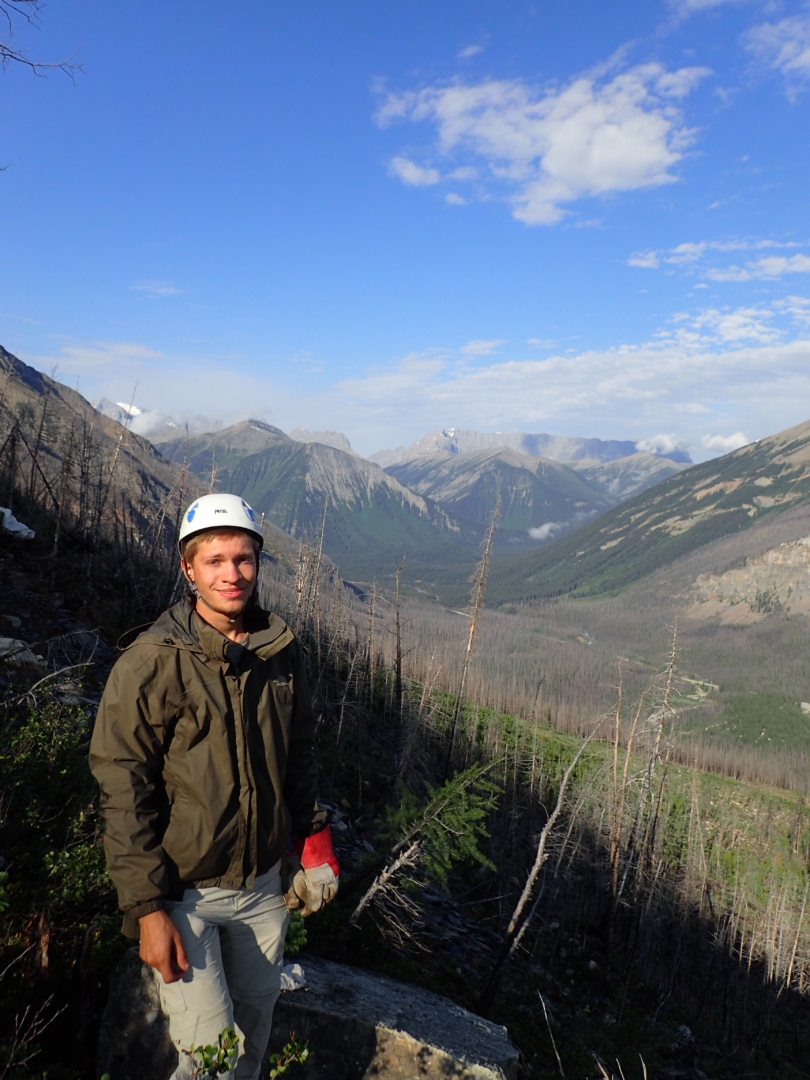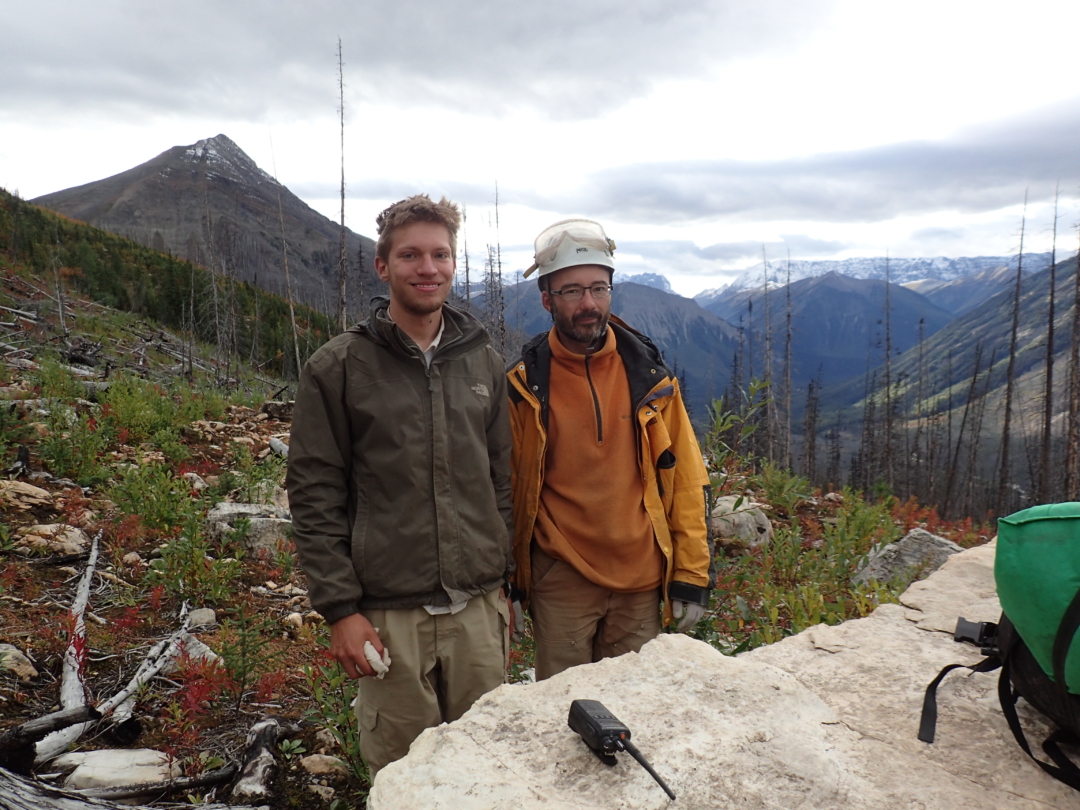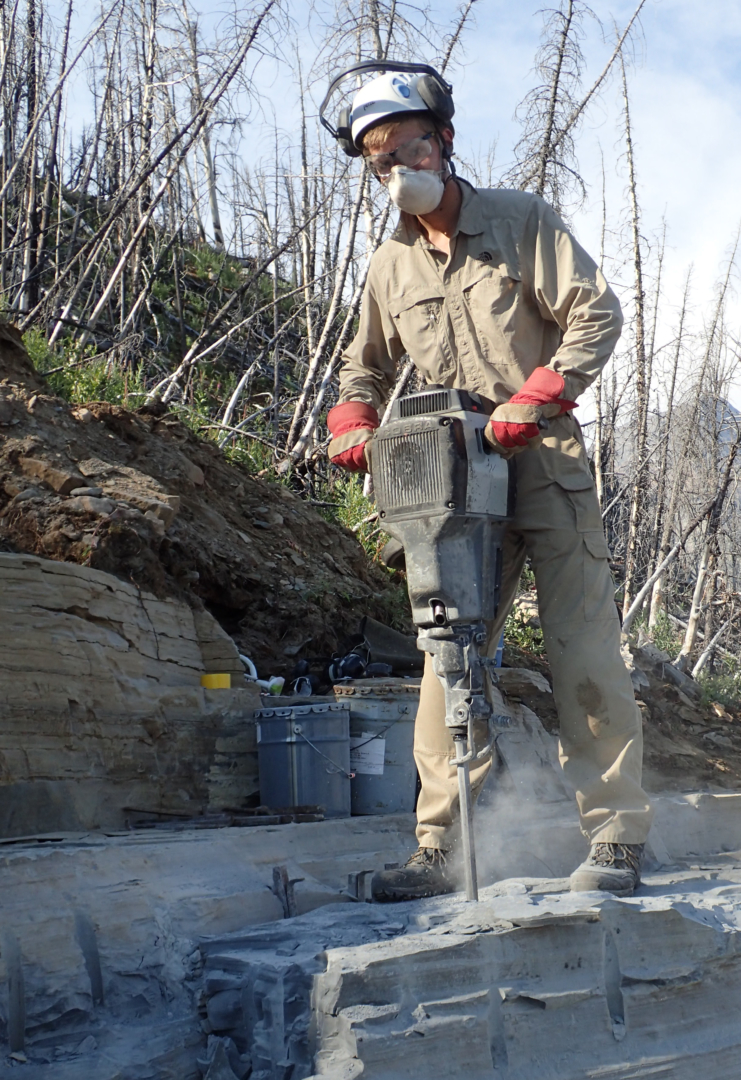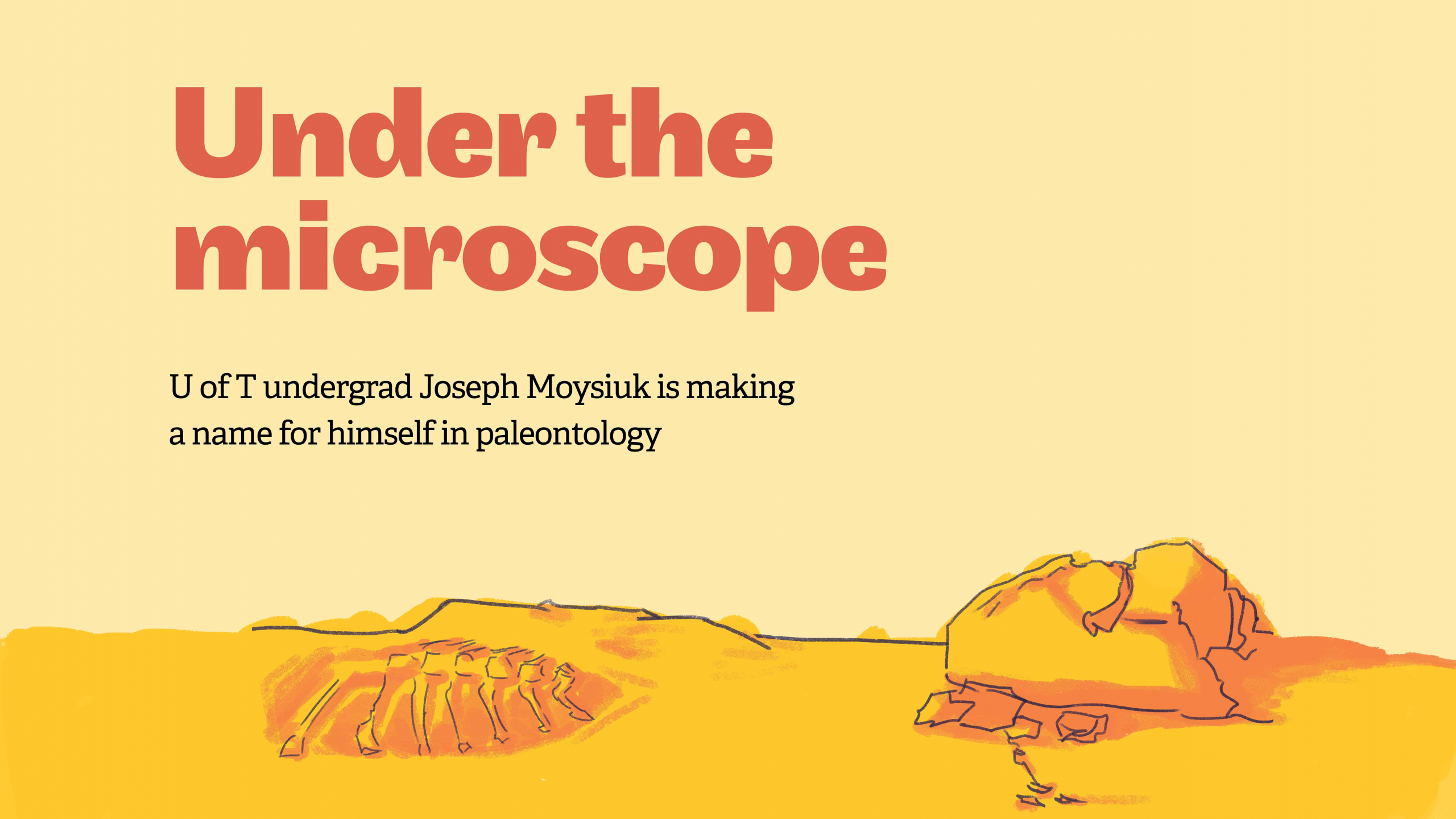[dropcap]A[/dropcap]s a child, Joseph Moysiuk was fascinated by the rocks at his local ravine. There, he would discover fossils and think, ‘What are these things?’
Moysiuk, a fourth-year Earth Sciences and Ecology & Evolutionary Biology (EEB) student at Victoria College, made headlines last year for his research on a group of extinct cone-shaped animals called hyoliths; the paper, which he co-authored, was published in the science journal Nature.
The hyoliths were previously thought to be part of a group of animals called molluscs, but Moysiuk’s paper, “Hyoliths are Paleozoic Lophophorates,” explains that they are more closely related to another group, called brachiopods.
Although it might not seem extraordinary to those who aren’t well versed in fossils, the discovery has broken new grounds — and Moysiuk is just getting started.
A “first taste” of paleontology, Toronto-style
Moysiuk’s curiosity about unfamiliar rocks is what first led him to the Royal Ontario Museum (ROM). As a kid, he would bring his findings to the ROM’s Rock, Gem, Mineral, Fossil, and Meteorite Identification Clinics, where the museum’s curators would help him identify them.
“That was kind of my first taste into paleontology and what really started me into this field,” he says.
These identification clinics sparked his ongoing involvement with the ROM. While attending Etobicoke Collegiate Institute, he was given the opportunity to get involved through his high school’s co-op program.
“That was like five years ago now, and I’ve been hanging around ever since. They can’t get rid of me,” says Moysiuk.
Moysiuk chose to attend U of T because of its “unique affiliation with the ROM.” He cites Jean-Bernard Caron’s dual role as the senior curator of Invertebrate Paleontology at the ROM and an associate professor in the EEB department. Moysiuk was interested in working further with the professors and conducting research himself.
The Research Opportunity Program (ROP) at U of T, which allows second- and third-year Arts & Science students to work on a professor’s research project, gave him the opportunity to make his hopes a reality.
Through the program, Moysiuk conducted research under Caron. Martin Smith from Durham University was also a part of the research team.
Prior to the ROP, Moysiuk had only worked in collections management roles, but the program allowed him to get hands-on research experience. “The ROP gave me the first chance to actually study the fossils and maybe learn something new about them that we didn’t know before,” he says.

Photo Courtesy of Joseph Moysiuk.
The methods behind the paleontological madness
The ROM’s expansive collection of hyoliths, which according to Moysiuk “nobody had really looked at” before, inspired Moysiuk and Caron to embark on the project that has now introduced Moysiuk’s name to the wider world of paleontology.
“It seemed like it was a project that was potentially right for something. We didn’t really know what at the time,” he says.
They began the project by going through all the hyolith specimens, taking inventory of them, and forming a hypothesis using the information gathered, a process that took up a fair part of that year.
Excavations that Moysiuk participated in before beginning his ROP from the Burgess Shale at the Kootenay National Park provided a lot of new material that became fundamental to the study. The fossils found at Burgess preserved the hyoliths’ soft tissue details particularly well, allowing the research team to observe details that were not visible in previous fossils.
The fossils collected from the shale were preserved as carbon films. “That’s like if you took an organism and just flattened it onto the rock and heated it so you burn off everything except the carbon,” explains Moysiuk.
Soft tissues of organisms are typically made of compounds of organic carbon, so the carbon film preservation made sure much of the soft tissue detail was well preserved.
These small details required special equipment to analyze. They used a scanning electron microscope, which allowed them to examine the chemical composition of the fossils. Some details were only visible under polarized light that cut down on the reflection of the rocks, thus making the features more visible.
Visualizing fossils through scanning electron microscopy allows researchers to observe what is overprinted from the fossilization process and what the original matter is. This became particularly valuable in the analysis of fossils from the Burgess Shale.
Using the scanning electron microscope, the team looked at “what preservation factors have affected these fossils that might affect our interpretation of the anatomy,” says Moysiuk.
“Basically, my first few months of the ROP program was going through the collections, looking at every single specimen under the microscope, and seeing, ‘What do we have?’ ‘Is there anything important here?’” explains Moysiuk. “Once we had selected some kind of specimens that seem to be more important, we try other techniques of imaging them to see if we can tease out some more aspects of their morphology.”
One of those techniques was using a scanning electron microscope, a device that allows researchers to examine the chemical composition of fossils.
“One of the tricky things about studying fossils is we’re always trying to interpret the anatomy of these organisms, but kind of overprinted on that anatomy [are] all of the changes that have affected the organism between the time that it died and was buried, and it’s gone through 500 million years of alteration, of heat, pressure, fluids passing through the rock,” says Moysiuk.

Photo Courtesy of Joseph Moysiuk.
Discovering a new branch in the evolutionary tree
Prior to Moysiuk’s research, there wasn’t much clarity as to how hyoliths should be classified. While they were presumed to be related to molluscs, there wasn’t much concrete research to verify it.
Hyoliths did not fit nicely into any evolutionary scheme. While many hyolith fossils were found and identified, they remained either unclassified or were assumed to be likely molluscs, until now.
“People have been puzzling over them for 175 years, and most people have been saying, ‘Oh, these things are probably molluscs, they’re probably related to squid, clams, snails.’ They didn’t have a lot of evidence to back that up, but they said it enough that no one else had any better ideas to refute that.”
The key finding associating hyoliths with brachiopods was their feeding apparatus. Hyoliths fed from a ring of tentacles around their mouth, sandwiched between two shells, called the lophophore.
The presence of the lophophore shows that the hyolith was part of a larger group of animals called the lophophorates, which include modern brachiopods and horseshoe worms. This new anatomical knowledge suggested that hyoliths were related to the brachiopod group, as the brachiopod is the only modern animal that has a similar configuration of shells and tentacles.
Although many features of the hyoliths aligned with those of the brachiopods, other hyolith features, such as their elongated cone-shaped shell, are not present in brachiopods today.
These features are instead found in other brachiopod relatives, like horseshoe worms. “Hyoliths have brachiopod-like shells but an elongated body like the horseshoe worm, and that puts them kind of between these two lineages,” says Moysiuk.
Moysiuk, Caron, and Smith consider the hyolith a transitional form.
“Being that kind of intermediate between these two groups is telling us something about the evolution of both and the origin of both of these groups and how both of them have come to be in the modern world,” says Moysiuk.
One of the researchers’ goals was to better understand the biodiversity of the world.
“All living animals can trace their ancestry back to the Cambrian explosion 500 million years ago, and so, by studying the different, bizarre animals that lived back then, [we’re] starting to be able to tease out how biodiversity came to be.”
With biodiversity at risk in many areas in the world, the value of understanding its origins is an important step toward helping protect it.

Photo Courtesy of Joseph Moysiuk.
Learning lessons and continuing the hot streak
While the opportunity to help discover such a significant part of the evolutionary puzzle is astonishing, Moysiuk also emphasizes the learning process involved.
“It’s one thing to do a literature review, and it’s another thing to take it to the next step and think beyond what other people have said,” he says.
The research project has opened his eyes to many of the more formal aspects of research, from communicating long-distance with his fellow researchers — Caron at the ROM and Smith in the United Kingdom — to the submission and peer-review process of scientific journaling.
“It was eye-opening to see this process that I’ve heard about,” says Moysiuk. “It’s very different to do it yourself.”
Despite the hurdles that he had to face while adjusting to the research process, he has learned a lot and has accomplished things that he never expected, citing his experience giving a talk at the ROM.
“I was able to give a talk at the ROM, it’s in their big speaking hall, to like 300 people, but wow. That’s definitely not something that I expected to get out of my undergrad, but it’s been amazing,” he says.
One of the most gratifying parts of conducting his research, however, was seeing that it actually had impact in the scientific world.
“To see that the research that I’ve done is having an impact beyond this university [is] something that I’ve always wanted to work towards, and it’s just really gratifying to see that the research [is] contributing to the body of science,” he says.
As he finishes his last year of his undergraduate degree, Moysiuk hopes to continue with graduate studies in paleontology.
He is currently working on another project studying a different group of fossils collected from Kootenay National Park: the agnostids. While they are known to be orthopods — meaning they are related to insects, spiders, centipedes, and crabs — it has been hotly debated where they fit in.
For undergraduates who may be interested in pursuing research, Moysiuk’s advice is to get started early and take initiative.
“The earlier you start, the more you’re going to know about what you’re getting yourself into and the more chances that you’re going to have to be able to do different research along the way, and maybe you’ll discover something amazing.”


